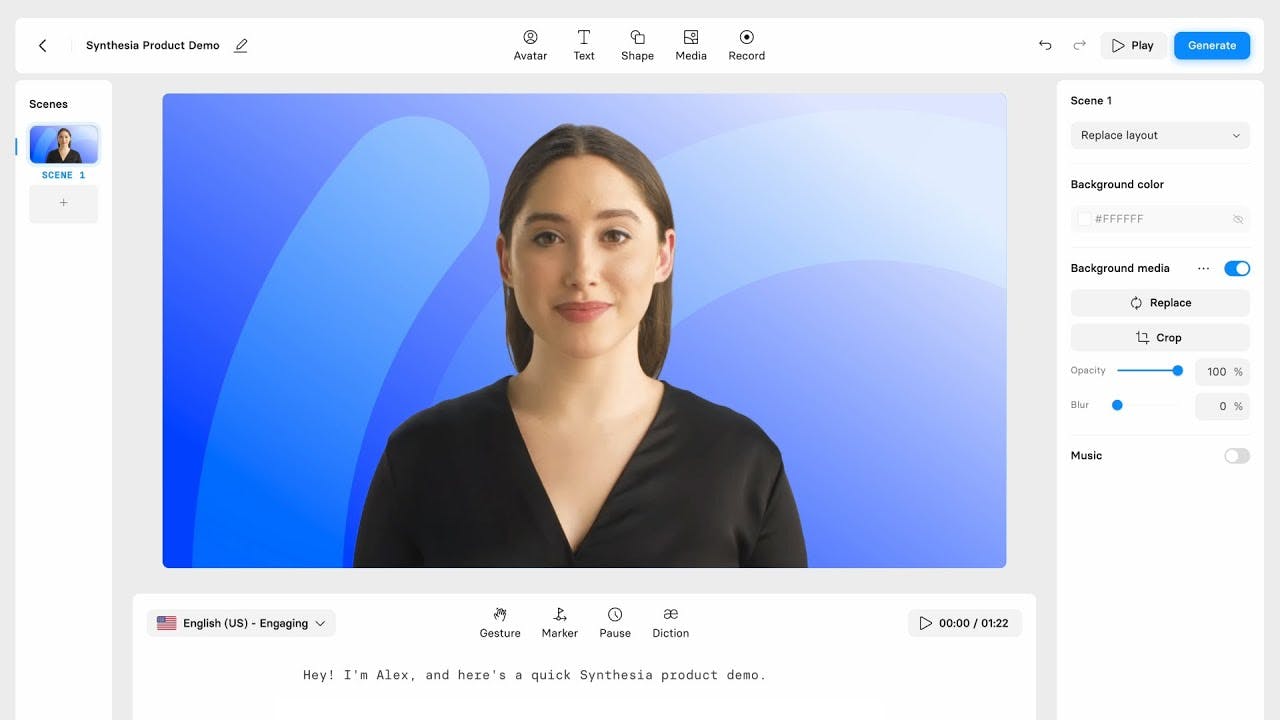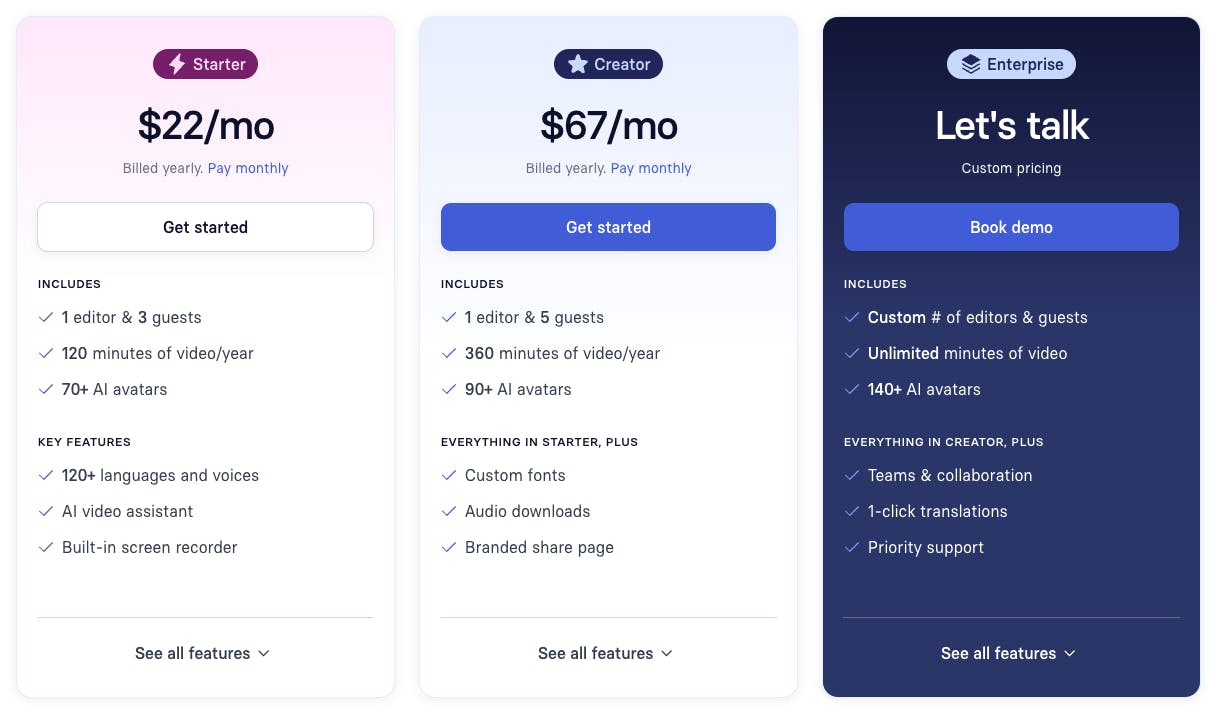
Revenue
$100.00M
2025
Valuation
$2.10B
2025
Funding
$330.00M
2025
Revenue
Sacra estimates that Synthesia hit $100 million in annual recurring revenue (ARR) in March 2025, up from $88M ARR at the end of 2024. The company has successfully built an enterprise-focused business, with 70% of its revenue derived from enterprise deals.
This strategy has allowed Synthesia to avoid challenges faced by AI companies that primarily target prosumers, which often struggle with sustainable growth and monetization.
Synthesia has achieved significant market penetration among major corporations, with over 60% of Fortune 100 companies utilizing their platform by 2025. The company serves over 60,000 customers globally, spanning organizations of various sizes.
Their revenue is geographically balanced, with approximately 50% coming from the United States and the remaining 50% split between Europe and Asia. This distribution indicates successful global market adoption.
Valuation
Synthesia is valued at $2.1 billion as of their Series D round in January 2025, which raised $180 million led by NEA (New Enterprise Associates).
The company has raised over $330 million in total funding across multiple rounds. Their valuation has more than doubled from the $1 billion mark achieved during their $90 million Series C in 2023, led by Accel and NVentures (NVIDIA's venture arm).
Key investors include NEA, Accel, NVentures, Kleiner Perkins, GV (Google Ventures), MMC Ventures, Atlassian Ventures, and PSP Growth. In April 2025, Synthesia also received a strategic investment from Adobe's venture arm as part of a partnership, though the amount was undisclosed.
Product

Synthesia is an AI-powered video generation platform that lets users create videos of realistic digital humans speaking any script without filming, cameras, or actors. Users simply log into the web-based Synthesia STUDIO, type or paste their text script, and select an AI avatar to deliver it.
The process starts with choosing from 230+ pre-recorded AI avatars (representing diverse demographics) or creating a custom "digital twin" of a real person (with their consent). Users can compose scenes by positioning the avatar against various backgrounds, adding on-screen text or graphics, and arranging these elements using templates or from scratch.
After entering their script and selecting an avatar, users click "Generate" and Synthesia's AI handles the heavy lifting—synthesizing natural-sounding speech in any of 140+ languages and animating the avatar's facial movements to perfectly match that speech. The result is a professional-looking video delivered in minutes that appears as if a real person recorded it.
For enterprises, the platform allows teams to collaborate on videos, with commenting and editing features. Custom avatars are typically created by filming a real person reading a script in a controlled environment, though newer "selfie avatar" features enable users to create their own avatar using just a smartphone video.
Most companies use Synthesia for internal communications (CEO messages, policy updates), training modules (where the same content might need translation into multiple languages), corporate explainer videos, and sales outreach. A key selling point is the platform's ability to translate videos into 40+ languages with one click, letting global companies create localized content without separate filming sessions.
The platform delivers standard video files that can be played anywhere, embedded in websites, learning management systems, or shared through communication channels.
Business Model

Synthesia operates a Software-as-a-Service (SaaS) model with a B2B focus, though it incorporates self-service elements for smaller customers. The core value proposition is dramatically reducing the cost, time, and expertise needed to produce professional video content at scale.
The company's go-to-market strategy blends two approaches. For small businesses and individuals, Synthesia offers self-service subscription plans available directly through their website. For large enterprises, they employ a dedicated sales team that handles custom negotiations, implementation, and customer success.
Monetization occurs primarily through tiered subscription fees based on usage limits and features. The typical structure includes a Starter plan ($30/month) with approximately 10 minutes of video generation monthly, a mid-tier Creator plan ($80-90/month) with increased limits and priority support, and custom-priced Enterprise plans with high or unlimited usage, enhanced security features, and API access.
The pricing model aligns cost with value—small users pay a modest fee while enterprises with extensive needs pay substantially more. Usage-based overages ensure that heavy users contribute proportionally more revenue. This model generates predictable, recurring revenue while allowing for natural expansion as customers increase their usage.
From a cost perspective, Synthesia maintains high gross margins typical of software businesses, likely in the 80%+ range. The main costs are R&D (the company employs over 400 people across 7 countries, many in engineering roles), cloud computing for video rendering, and general operations. Each video generation incurs variable costs in GPU processing, but these are significantly lower than the subscription fees, resulting in profitable unit economics.
A key business model differentiator is Synthesia's focus on security, compliance, and responsible AI use. The company has invested in obtaining SOC 2, GDPR, and ISO 27001 certifications, which creates a competitive advantage with risk-averse corporate buyers. Their strict policies against unauthorized deepfakes or misuse provide reassurance to enterprise clients, even if it means turning away some potential use cases.
This enterprise-grade positioning has allowed Synthesia to command premium pricing and win major corporate deals despite the entrance of lower-priced competitors.
Competition
Enterprise-focused platforms
Synthesia's primary direct competitors include Colossyan, which targets corporate learning and development departments with a similar AI avatar video creation platform. Colossyan raised a $22M Series A in 2023 but remains smaller than Synthesia in market presence.
Hour One competes in the same space with its virtual human platform for businesses, focusing on ecommerce and marketing content. They raised about $20M in Series A funding in 2022 and offer slightly lower pricing with some free video minutes to attract users.
Both competitors offer comparable basic functionality (text-to-video with avatars in multiple languages), but Synthesia maintains advantages in enterprise security features, collaboration tools, and the breadth of its avatar library.
Consumer-friendly innovators
HeyGen represents the fastest-growing competitive threat, with ARR estimated at $22M in May 2024, up 1024% year-over-year. HeyGen has gained traction through aggressive marketing and innovation in avatar creation technology.
While Synthesia initially required professional filming sessions for custom avatars, HeyGen pioneered an "Instant Avatar" tool that creates custom avatars from smartphone selfie videos in minutes, significantly reducing the barrier to personalization. Synthesia has since developed similar "Selfie Avatar" functionality.
HeyGen operates at a slightly lower price point and appears more focused on individual creators and small businesses alongside enterprise clients, compared to Synthesia's stronger enterprise orientation.
API and platform integrators
Tavus represents a fundamentally different strategic approach to the AI avatar video market. While Synthesia and HeyGen build end-user SaaS products, Tavus is developing APIs and developer tooling that can embed AI avatar generation directly into other software platforms.
This model bets on a future where AI talking head videos become a native feature within existing business software like HubSpot (for sales and marketing), Intercom (for customer support), or Shopify (for ecommerce) rather than being created in standalone video platforms.
This approach could potentially disrupt the standalone SaaS model if successful, as it would make avatar video creation a commodity feature rather than a dedicated application. Synthesia's enterprise relationships and focus on quality could provide some defense against this threat.
Adjacent alternatives
Beyond dedicated AI avatar platforms, Synthesia faces indirect competition from traditional video production (filming with real actors), animated explainer tools like Vyond or Powtoon, and text-to-video tools like Lumen5 that create slideshow-style videos without human presenters.
As generative AI advances, research projects from tech giants like Google and Meta that can generate entire video scenes from text prompts (not just talking heads) could eventually evolve into commercial products that compete with Synthesia's more structured approach.
Some companies like Adobe (which strategically invested in Synthesia) could potentially integrate avatar generation into their existing video editing products, blurring the line between traditional video production and AI generation.
TAM Expansion
Interactive AI video agents
Synthesia's most promising expansion vector is evolving from static, one-way video content to interactive video experiences. The company is actively developing technology that will allow avatar videos to respond to viewer questions in real-time.
This would essentially merge Synthesia's realistic avatar video capabilities with backend AI systems like large language models to create conversational video agents. For example, a customer could ask an AI avatar questions about a product, and the system would generate a relevant video response on the fly.
Synthesia plans to release its first interactive video agent tool in the first half of 2025. This expansion would move the company beyond content creation into interactive experiences—entering markets served by chatbots, call center AI, and even certain functions performed by live instructors or sales representatives.
The interactive capability could significantly expand Synthesia's addressable market by capturing time-sensitive use cases that static videos can't handle, such as customer support, sales qualification, and personalized education.
Vertical market penetration
While Synthesia currently focuses on internal corporate communications and training, deeper penetration into specific verticals represents a substantial growth opportunity.
The education sector is particularly promising. Schools, universities, online course creators, and educational publishers could use Synthesia to create lecture content, tutoring materials, and explanatory videos in multiple languages. This could transform how educational content is created and localized globally.
The media and news sector offers another expansion path. Digital media outlets could use AI anchors for routine news reports, especially for localizing content across regions or languages. Advertising agencies could create hyper-localized campaigns by swapping avatar ethnicity, language, and cultural references while maintaining consistent messaging.
Government and public sector organizations present a third significant vertical. These entities often need to produce public information content in multiple languages (health guidelines, citizen services information) and could benefit from Synthesia's rapid video creation and translation capabilities.
Geographic expansion and localization
While Synthesia already serves global clients, more focused geographic expansion could drive substantial growth, particularly in regions with unique language needs or content regulations.
Japan represents a strategic target market, with Synthesia earmarking part of its 2025 funding for expansion there. This would require developing avatars that match Japanese business customs and appearance norms, plus marketing efforts tailored to local business practices.
Similar opportunities exist across Asia, where video communication is particularly valued and multilingual content is essential for business. Developing region-specific avatars (with appropriate cultural attire, speaking styles, and gestures) could open doors to new markets.
Expanding into regulated industries in different countries (healthcare, finance, government) would require adapting to local compliance frameworks, but would unlock significant enterprise value. Synthesia's existing focus on security and compliance positions it well for this expansion.
Risks
Ethical misuse concerns: Synthesia's technology enables the creation of realistic videos of people saying things they never actually said, which carries inherent risks of misuse for disinformation or deception. A 2023 incident where Synthesia's platform was allegedly used to create propaganda videos for an authoritarian regime in Burkina Faso (violating the company's terms) highlights the challenge of preventing misuse at scale while maintaining an accessible service.
Technological commoditization: The core technology of generating talking head videos from text is being replicated by an increasing number of competitors at lower price points. As open-source AI models improve and democratize this capability, Synthesia faces pressure to continuously innovate on quality and features to justify its premium positioning or risk seeing its technology become a commodity feature integrated into broader platforms.
Regulatory uncertainty: The regulatory landscape for AI-generated media is rapidly evolving globally. New rules could require visible disclosure of AI-generated content (watermarks, disclaimers), restrict certain applications, or impose significant compliance costs. These potential regulations could impact customer adoption if they reduce the perceived authenticity of the content or add friction to the creation process.
News
DISCLAIMERS
This report is for information purposes only and is not to be used or considered as an offer or the solicitation of an offer to sell or to buy or subscribe for securities or other financial instruments. Nothing in this report constitutes investment, legal, accounting or tax advice or a representation that any investment or strategy is suitable or appropriate to your individual circumstances or otherwise constitutes a personal trade recommendation to you.
This research report has been prepared solely by Sacra and should not be considered a product of any person or entity that makes such report available, if any.
Information and opinions presented in the sections of the report were obtained or derived from sources Sacra believes are reliable, but Sacra makes no representation as to their accuracy or completeness. Past performance should not be taken as an indication or guarantee of future performance, and no representation or warranty, express or implied, is made regarding future performance. Information, opinions and estimates contained in this report reflect a determination at its original date of publication by Sacra and are subject to change without notice.
Sacra accepts no liability for loss arising from the use of the material presented in this report, except that this exclusion of liability does not apply to the extent that liability arises under specific statutes or regulations applicable to Sacra. Sacra may have issued, and may in the future issue, other reports that are inconsistent with, and reach different conclusions from, the information presented in this report. Those reports reflect different assumptions, views and analytical methods of the analysts who prepared them and Sacra is under no obligation to ensure that such other reports are brought to the attention of any recipient of this report.
All rights reserved. All material presented in this report, unless specifically indicated otherwise is under copyright to Sacra. Sacra reserves any and all intellectual property rights in the report. All trademarks, service marks and logos used in this report are trademarks or service marks or registered trademarks or service marks of Sacra. Any modification, copying, displaying, distributing, transmitting, publishing, licensing, creating derivative works from, or selling any report is strictly prohibited. None of the material, nor its content, nor any copy of it, may be altered in any way, transmitted to, copied or distributed to any other party, without the prior express written permission of Sacra. Any unauthorized duplication, redistribution or disclosure of this report will result in prosecution.